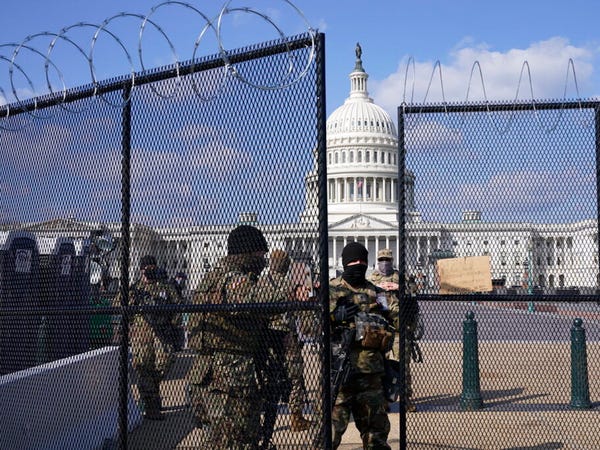QAnon March 4 failure: Conspiracy theory now prophesizes March 20
- QAnon followers believed that Donald Trump would be reinstated as president on Thursday.
- The date was the latest in a long line of bizarre and continually shifting goalposts.
- Followers of the conspiracy theory now say future dates will herald epic changes.
“Don’t be disappointed,” one subscriber wrote on a popular QAnon Telegram channel late Thursday. “The race is not run yet and I have reason to believe March 20 is also possible.”
Another posted a similarly optimistic message. “We still have 16 days,” they wrote. “Lots can happen between now and then!”
With the passing of March 4, a highly anticipated date for followers of the QAnon conspiracy theory, some remain characteristically delusional. They spent Friday morning urging other followers to look forward and “keep the faith.”
QAnon’s March 4 failure
When “the storm” — the promise of mass arrests and executions on President Joe Biden’s Inauguration Day —amounted to nothing, QAnon followers scrambled for a new date to imagine a swearing-in ceremony for Donald Trump.
March 4, like several fruitless dates before it, was born of a convoluted political fantasy.
QAnon adherents borrowed from the obscure sovereign-citizen movement to suggest that Trump would return to power on March 4. Followers of that movement “believe that they get to decide which laws to obey and which to ignore,” according to the Southern Poverty Law Center, a nonprofit organization that tracks extremism.
The theory is rooted in a bizarre belief that all laws after the 14th Amendment, ratified in 1868, are illegitimate. Followers of the movement view the 20th Amendment, which moved Inauguration Day from March 4 to January 20, as invalid.
Proponents of this conspiracy theory insisted that Trump would restore a republic that has been out of action for over 150 years on that day.
Travis View, a conspiracy-theory expert and host of the “QAnon Anonymous” podcast, previously told Insider that the idea was based on a “blind faith” that Trump can “fix everything.”
Experts say the conspiracy-theory movement will continue to invent new dates to look forward to, or else their years of believing will have been for naught.
“Reality doesn’t really matter,” Nick Backovic, a contributing editor at the fact-checking website Logically who researches misinformation and disinformation, told Insider. “Whether QAnon can survive another great disappointment, there’s no question — it can.”
A series of no-shows
Before March 4, the QAnon follower’s calendar was marked with dates that had been hailed as moments of reckoning but didn’t happen.
In 2017, the first “Q drop” — the cryptic messages from the anonymous “Q” figure behind the movement — claimed that former Secretary of State Hillary Clinton would soon be arrested, based on an unfounded allegation that she was involved in child sex trafficking. This, of course, never happened, but the QAnon conspiracy theory was born.
Devotees of the conspiracy theory eagerly anticipated the release of the Mueller report in 2019, expecting its findings to lead to the arrest and possibly the execution of leading Democrats. Once again, QAnon believers were disappointed.
Then, in a bid to reconcile their belief that Trump would remain president, they believed that January 6, the date of the deadly insurrection at the US Capitol, was a precursor to “the storm,” a violent event that would result in the execution of child-abusive elites.
The goalpost was moved to January 20, when Trump would seize power before Biden could take his oath.

But Trump was not inaugurated again on January 20. He left Washington, DC, to move to Florida. Some QAnon believers were left confused and crestfallen.
Mental gymnastics ensued. Some QAnon influencers argued that Biden’s inauguration had happened in a Hollywood studio and was therefore invalid; others claimed that Trump had sent signals in his final address indicating that he’d remain in office. These influencers promoted to their followers the idea that, somehow, their theory was not yet over.
“QAnon is dealing with a very difficult cognitive-dissonance situation,” Michael Barkun, a professor emeritus of political science at Syracuse University, told Insider.
Some believers become fed up with failures
Several top QAnon voices disavowed the March 4 conspiracy theory. These influencers have likely been attempting to keep their followers on board with the QAnon conspiracy theory despite its myriad disappointments, Backovic told Insider.
A post on Wednesday on a QAnon Telegram channel with nearly 200,000 subscribers called the plan “BS” — though the same page had told its followers that the “new Republic” would begin on March 4.
Another top conspiracy theorist told their 71,000 subscribers on Wednesday morning that a “Q drop” had contained a hint that the March 4 conspiracy theory was a false flag. “March 4 is a Trap,” the post said.

Whenever QAnon’s prophecies are proved wrong, the movement does lose some support, Backovic said.
In the days after Biden’s inauguration, many QAnon believers expressed a desire to leave the movement, fed up with the lies they’d been told. Even Ron Watkins, once QAnon’s top source for voter-fraud misinformation, told his 134,000 Telegram subscribers on the afternoon of January 20, “Now we need to keep our chins up and go back to our lives as best we are able.”
QAnon influencers calling March 4 a “false flag” also helps to place the blame on others in case things go awry, as they did on January 6. Finding a scapegoat is a common tactic for extremists, Backovic said.
After the Capitol insurrection, QAnon supporters and other Trump supporters — and several Republicans in Congress — spread the false claim that antifa, the anti-fascist movement, had staged it.
FBI Director Christopher Wray told Congress on Tuesday that there was no evidence that antifa was involved in the riot.
QAnon has adapted to include other conspiracy theories and enter more conventional spaces. Last spring, the movement pivoted to focus on human trafficking, making “Save the Children” its new battle cry. QAnon leveraged mainstream social media, including Instagram, where lifestyle influencers spread the conspiracy theory.
And last fall, QAnon extremists joined with other right-wing groups to protest Biden’s election win as part of the “Stop the Steal” movement, which led to the Capitol insurrection.

After nothing happened on March 4, believers are looking forward, again
The latest disappointment has led to the introduction of new dates, with increasingly desperate explanations.
Some QAnon influencers have suggested that March 20 is when Trump will seize control. It appears to be a misinterpretation of the Presidential Transition Enhancement Act of 2019, which provides certain transition-related services to an administration up to 60 days after the inauguration.
The claim, first made on a popular QAnon Telegram channel, appeared to be gaining ground with supporters offline too. A QAnon supporter told The Washington Post’s Dave Weigel over the weekend that he believes that Trump remains in command of the military and will be inaugurated on March 20.
—Dave Weigel (@daveweigel) February 28, 2021
Some followers of the conspiracy theory are reluctant to throw all their weight behind a particular date.
In another Telegram message board for QAnon believers, one post encouraged people to remain open-minded about Q’s plan. “Dates for late March, April, May, and more dates in the fall have been tossed out there,” the post said. “While we can speculate and hope, no specific dates have been landed on… don’t get caught up in the dates, watch what’s happening.”
Others are simply set on a resounding victory for Trump in 2024.
“Whether it’s some date in March or whether ultimately it will be a second Trump term after an election in 2024,” Barkun told Insider, “there will be some further set of explanations and a further set of dates.”
The cycle continues.


